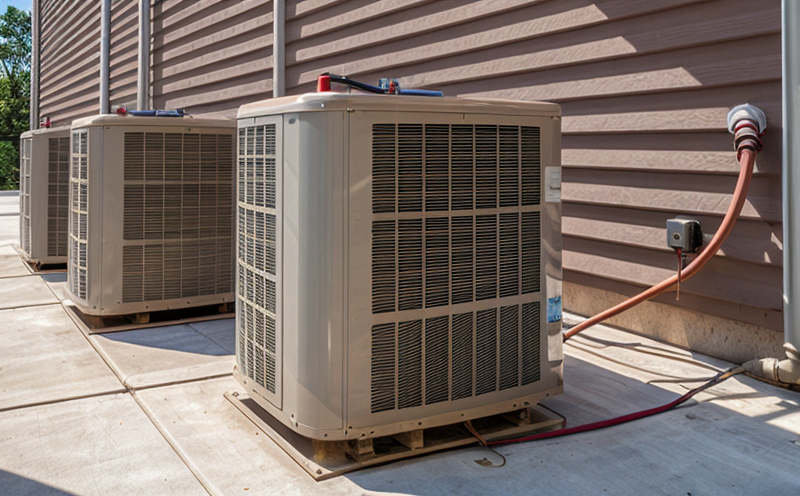EN 308 Heat Exchangers Testing
The EN 308 standard provides a framework for testing heat exchangers, ensuring they meet the necessary performance and safety criteria. This service is essential for quality managers, compliance officers, R&D engineers, and procurement teams to ensure that heat exchangers are up to the required specifications.
Heat exchangers play a crucial role in HVAC systems by transferring heat from one fluid to another without mixing them. They are widely used in various sectors including building & infrastructure, manufacturing, and energy production. The testing of these components must be conducted meticulously to ensure they operate efficiently and safely.
The EN 308 standard specifies the test methods for determining thermal performance, pressure drop, and other critical parameters. This ensures that heat exchangers are reliable and efficient in real-world conditions. Testing is not only about meeting regulatory requirements but also optimizing system performance and ensuring safety.
During testing, the specimen preparation involves careful selection of materials and components to simulate actual usage conditions. The test apparatus used includes temperature-controlled chambers, pressure vessels, and flow measurement devices. These instruments provide precise data on thermal efficiency, pressure drop, and fluid velocity.
The acceptance criteria for heat exchangers under EN 308 are stringent. They include both quantitative measures such as heat transfer coefficient and qualitative assessments like durability and safety factors. Compliance with these standards ensures that the heat exchanger will perform optimally in its intended application.
| Standard Number | Description |
|---|---|
| EN 308 | Heat Exchangers - Thermal Performance and Pressure Drop |
| ISO 9227 | Water-Cooled Condensers for Refrigeration Plants |
- Thermal Performance: The heat exchanger must achieve a specific thermal efficiency as defined by the standard.
- Pressure Drop: The pressure drop across the heat exchanger should not exceed certain limits specified in EN 308.
The testing process involves several steps, including initial inspection of the equipment, setting up the test chamber with controlled parameters, running the tests under various conditions, and finally analyzing the results. The data collected is then used to determine if the heat exchanger meets all specified criteria.
Real-world applications of EN 308 testing include ensuring that HVAC systems in large buildings meet energy efficiency standards while also maintaining occupant comfort. In industrial settings, it helps verify that equipment operates safely and efficiently under demanding conditions. By adhering to these tests, organizations can ensure they are meeting both local regulations and international best practices.
| Application Example | Description |
|---|---|
| HVAC Systems in Commercial Buildings | Testing ensures that heat exchangers function efficiently, contributing to lower energy costs and improved air quality. |
| Industrial HVAC Equipment | Ensures reliability and safety in harsh industrial environments where failures could lead to significant downtime or accidents. |
Applied Standards
The EN 308 standard is complemented by other international standards that provide additional guidance on specific aspects of heat exchanger testing. For instance, ISO 9227 covers water-cooled condensers for refrigeration plants, which are a common type of heat exchanger used in HVAC systems.
| Standard Number | Description |
|---|---|
| EN 308 | Heat Exchangers - Thermal Performance and Pressure Drop |
| ISO 9227 | Water-Cooled Condensers for Refrigeration Plants |
- Thermal Performance: The heat exchanger must achieve a specific thermal efficiency as defined by the standard.
- Pressure Drop: The pressure drop across the heat exchanger should not exceed certain limits specified in EN 308.
The combination of these standards ensures that all aspects of heat exchanger performance are thoroughly evaluated, providing comprehensive data for decision-making and quality assurance.
International Acceptance and Recognition
The EN 308 standard is widely recognized across Europe and beyond. It is adopted by many countries that align their regulations with European standards, ensuring consistent quality and performance expectations.
- Countries: Germany, France, Italy, Spain, the United Kingdom
- Areas of Application: HVAC systems in buildings, industrial plants, and commercial facilities.
This standardization facilitates international trade by ensuring that heat exchangers meet the same performance criteria regardless of where they are manufactured or used. Compliance with EN 308 is often a requirement for exporting products to Europe and other regions that recognize this standard.
Use Cases and Application Examples
| Application Example | Description |
|---|---|
| HVAC Systems in Commercial Buildings | Testing ensures that heat exchangers function efficiently, contributing to lower energy costs and improved air quality. |
| Industrial HVAC Equipment | Ensures reliability and safety in harsh industrial environments where failures could lead to significant downtime or accidents. |
In commercial buildings, the testing of heat exchangers is crucial for maintaining optimal indoor air quality and energy efficiency. In industrial settings, it ensures that equipment operates safely and efficiently under demanding conditions. By adhering to these tests, organizations can ensure they are meeting both local regulations and international best practices.





